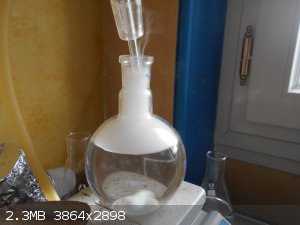BaFuxa
Hazard to Self
 
Posts: 61
Registered: 18-9-2017
Location: Mars
Member Is Offline
Mood: Buzzing
|
|
Ammonium Carbonate and Ammonia Vapor ?
Hi,
Just attempted making some ammonium carbonate.
I bubbled CO2 into aqueous ammonia, from calcium carbonate ( chalks ) and HCL. I noticed that a heavy ammonia (?) vapor spreading over the surface.
Any idea what this is ? To me the reaction is 2NH3 (l) + CO2(g) + H2O(l) -> (NH4)2 CO3
Why do I get this vapor, is it not supposed to be reacting with the CO2 ? For comparison I bubbled air and expired into the solution of aqueous
ammonia and nothing happened.
Edit : photo added.
[Edited on 12-2-2018 by BaFuxa]

[Edited on 12-2-2018 by BaFuxa]
Potential counts for nothing until realized.
|
|
|
JJay
International Hazard
    
Posts: 3440
Registered: 15-10-2015
Member Is Offline
|
|
Does it look like smoke?
|
|
|
BaFuxa
Hazard to Self
 
Posts: 61
Registered: 18-9-2017
Location: Mars
Member Is Offline
Mood: Buzzing
|
|
Yes it does.
By the way how do you insert photos ( "Please enter the URL to the image you wish to insert" : how to do that ?). ?
Potential counts for nothing until realized.
|
|
|
happyfooddance
National Hazard
   
Posts: 530
Registered: 9-11-2017
Location: Los Angeles, Ca.
Member Is Offline
Mood: No Mood
|
|
What temperature is your solution, and what concentration NH3? If you keep it cold you will have better results. Ammonium carbonate leaves solution
when heated, and the ammonia smell can be very, very strong.
|
|
|
BaFuxa
Hazard to Self
 
Posts: 61
Registered: 18-9-2017
Location: Mars
Member Is Offline
Mood: Buzzing
|
|
Temperature : RT ( 15 and 20° C), the NH3 concentration is 13%.
I noticed that this vapor crystallized over the inside of the flask as well.
Had no idea aqueous ammonium carbonate was such a crazy volatile 
Potential counts for nothing until realized.
|
|
|
Vosoryx
Hazard to Others
  
Posts: 282
Registered: 18-6-2017
Location: British Columbia, Canada
Member Is Offline
Mood: Serial Apple Enjoyer
|
|
Photos can be inserted by attaching the file below the text reply box. It took me a while to figure out.

The photos have to be saved to a drive in order to do this, they can't be copied in.
And, of course, the size limits also apply.
The "Insert image" button you used was for images online.
"Open your mind son, before someone opens it for you." - Dr. Walter Bishop
|
|
|
happyfooddance
National Hazard
   
Posts: 530
Registered: 9-11-2017
Location: Los Angeles, Ca.
Member Is Offline
Mood: No Mood
|
|
Quote: Originally posted by BaFuxa  | Temperature : RT ( 15 and 20° C), the NH3 concentration is 13%.
I noticed that this vapor crystallized over the inside of the flask as well.
Had no idea aqueous ammonium carbonate was such a crazy volatile 
|
Sounds like it's working then.
Add a little crushed ice, and add your CO2 slowly. You SHOULD scrub residual HCl from your CO2, but if you go slowly it won't be a problem, unless
chloride contamination is a problem for you.
Ammonium carbonate can be very bad. I have had a couple experiences that have led me to take great caution with this compound. Make sure your outlet
and all your tubing stays clear! When a layer cakes on the wall and you can't see inside, how do you know that it isn't a closed system?!?
Edit: adding CO2 is basically sparging the solution, that's why you want to do it slowly. Also, it isn't so much that ammonium carbonate (which is
really not that, but a variety of complexes...) is volatile, but that neutral CO2 and NH3 are very volatile, and these things find ambient water (
of which there is a lot of sitting over a flask of water) marry each other and crystallize.
[Edited on 2-12-2018 by happyfooddance]
|
|
|
MrHomeScientist
International Hazard
    
Posts: 1806
Registered: 24-10-2010
Location: Flerovium
Member Is Offline
Mood: No Mood
|
|
Looks similar to ammonium chloride smoke produced when HCl and NH3 vapors meet. I think happyfooddance is right in that this is a similar
reaction between gaseous CO2 and NH3 above the solution.
[Edited on 2-12-2018 by MrHomeScientist]
|
|
|
NEMO-Chemistry
International Hazard
    
Posts: 1559
Registered: 29-5-2016
Location: UK
Member Is Offline
Mood: No Mood
|
|
I would say HCl is getting through, Ammonia and HCl smoke ALOT  . Actually while
not recommended for a lab, i think some people have it in confectionery!! . Actually while
not recommended for a lab, i think some people have it in confectionery!!
HCl and Ammonia is how I tested the fan in my fume hood. That gave small crystals as well.
|
|
|
happyfooddance
National Hazard
   
Posts: 530
Registered: 9-11-2017
Location: Los Angeles, Ca.
Member Is Offline
Mood: No Mood
|
|
Quote: Originally posted by NEMO-Chemistry  | I would say HCl is getting through, Ammonia and HCl smoke ALOT  . Actually while
not recommended for a lab, i think some people have it in confectionery!! . Actually while
not recommended for a lab, i think some people have it in confectionery!!
HCl and Ammonia is how I tested the fan in my fume hood. That gave small crystals as well. |
In european licorice, ammonium chloride is very common. I can't think of a single other instance it is used. Ammonium carbonate is quite common in
specialty recipes; originally it was obtained by the dry distillation of deer antler: https://en.m.wikipedia.org/wiki/Hartshorn
|
|
|
semiconductive
Hazard to Others
  
Posts: 287
Registered: 12-2-2017
Location: Scappoose Oregon, USA.
Member Is Offline
Mood: Explorative
|
|
Quote: Originally posted by happyfooddance  | Quote: Originally posted by BaFuxa  | Temperature : RT ( 15 and 20° C), the NH3 concentration is 13%.
I noticed that this vapor crystallized over the inside of the flask as well.
Had no idea aqueous ammonium carbonate was such a crazy volatile 
|
Sounds like it's working then.
Add a little crushed ice, and add your CO2 slowly. You SHOULD scrub residual HCl from your CO2, but if you go slowly it won't be a problem, unless
chloride contamination is a problem for you.
Ammonium carbonate can be very bad. I have had a couple experiences that have led me to take great caution with this compound. Make sure your outlet
and all your tubing stays clear! When a layer cakes on the wall and you can't see inside, how do you know that it isn't a closed system?!?
Edit: adding CO2 is basically sparging the solution, that's why you want to do it slowly. Also, it isn't so much that ammonium carbonate (which is
really not that, but a variety of complexes...) is volatile, but that neutral CO2 and NH3 are very volatile, and these things find ambient water (
of which there is a lot of sitting over a flask of water) marry each other and crystallize.
[Edited on 2-12-2018 by happyfooddance] |
Awsome. I tried to make ammonium carbonate before, and used 90PSI CO2 (dry ice goes 800PSI in an old scuba tank with a regulator)... everything went
into solution in a champaign bottle. There was no smoke on top, even though the outside temperature was 10C in winter. Now that I see the reaction
happens in the air space above the liquid ... and that fast addition of CO2 is a mistake; I have a pretty good idea why my attempt failed.
It seems to me, that this experiment might be better done by heating an ammonia solution and carbonate solution in separate flasks and then piping the
gasses over to a third flask that is kept very cold on bottom (ice underneath?). Then the crystals would only want to form on the bottom of the flask
where it's cold and dry enough to be stable. That might also solve the problem of keeping the product from dissolving in the ammonia solution that
has a lot of water ... and is hard to separate.
I was hoping to use ammonium carbonate to replace wax in lost wax casting. Since NH4O3.??H2O leaves no residue when heated, and doesn't produce
carbon monoxide, it shouldn't hurt canthal heating elements like burning wax does. Ammonia's not fun, but it's better than strong hot CO !
[Edited on 12-2-2018 by semiconductive]
|
|
|
JJay
International Hazard
    
Posts: 3440
Registered: 15-10-2015
Member Is Offline
|
|
Those are my thoughts as well. Ammonia salts can produce thick smoke even in very low concentrations when gaseous ammonia reacts with airborne acid
anhydrides like HCl, SO2 and CO2.
|
|
|
happyfooddance
National Hazard
   
Posts: 530
Registered: 9-11-2017
Location: Los Angeles, Ca.
Member Is Offline
Mood: No Mood
|
|
Quote: Originally posted by MrHomeScientist  | Looks similar to ammonium chloride smoke produced when HCl and NH3 vapors meet. I think happyfooddance is right in that this is a similar
reaction between gaseous CO2 and NH3 above the solution.
[Edited on 2-12-2018 by MrHomeScientist] |
It is very different though, I think, personally... When you boil an ammonium chloride solution, you don't (in my experience) get any solid forming
over the solution. When you boil an ammonium carbonate solution, solids tend to condense above the solution: in the neck of the flask, in the
condenser... It is very dangerous, really.
OP should be using some sort of vapor trap. I once converted. 1.5 mol ammonium nitrate to NaNO3 with sodium bicarbonate, outdoors on a hotplate (after
my bad indoor experience), and standing about 20 feet away my eyes were burning.
|
|
|
zed
International Hazard
    
Posts: 2277
Registered: 6-9-2008
Location: Great State of Jefferson, City of Portland
Member Is Offline
Mood: Semi-repentant Sith Lord
|
|
Well yeah. Snap your head back, it will.
Used to be called "Smelling Salts". Victorian fainting medicine.
https://en.wikipedia.org/wiki/Smelling_salts
[Edited on 13-2-2018 by zed]
|
|
|